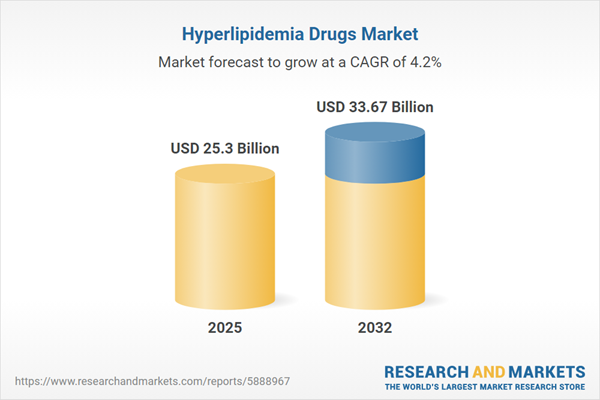Speak directly to the analyst to clarify any post sales queries you may have.
In a rapidly changing healthcare landscape, the hyperlipidemia drugs market presents senior executives with considerable opportunities and evolving challenges. As innovations in patient care, therapy modalities, and digital health redefine strategic priorities, leadership will require forward-thinking strategies to sustain value and strengthen positions in cardiovascular disease management.
Market Snapshot: Hyperlipidemia Drugs Market Growth and Trends
The hyperlipidemia drugs market recorded growth from USD 24.31 billion in 2024 to USD 25.30 billion in 2025 and is projected to reach USD 33.67 billion by 2032, at a compound annual growth rate (CAGR) of 4.15%. This performance is propelled by escalating global cardiovascular risk factors and expansion in advanced molecular therapy adoption. Significant market drivers include broadening treatment armamentariums for clinicians, accelerated digital transformation in patient access and diagnostics, and regulatory innovation. These dynamics are reshaping patient outcomes, driving efficiencies for health systems, and guiding industry leaders in product development, commercialization, and global partnership strategies.
Scope & Segmentation: Hyperlipidemia Drugs Market Deep Dive
- Drug Classes: Statins, bile acid sequestrants (cholestyramine, colesevelam), fibrates (fenofibrate, gemfibrozil), omega-3 fatty acids (DHA, EPA), and PCSK9 inhibitors (monoclonal antibodies, siRNA agents) constitute a multi-modal landscape supporting diverse care and innovation approaches.
- Distribution Channels: Hospital pharmacies, retail networks, and online platforms help ensure patient adherence and expand access, also facilitating new therapy delivery models.
- End Users: Clinics, home care, hospitals, and specialty centers reflect the trend toward more individualized, integrated care models and management priorities.
- Routes of Administration: Oral and injectable options provide versatility for clinical teams, enabling flexible, patient-focused therapy planning across populations.
- Patient Types: Adult and pediatric groups are served, including specialized frameworks for pediatric and familial hypercholesterolemia demanding specific intervention strategies.
- Hyperlipidemia Types: Primary and secondary hyperlipidemia are addressed, ensuring tailored solutions aligned with disease origins and monitoring protocols.
- Geographic Coverage: Comprehensive analysis spans the Americas (United States, Canada, Mexico, Brazil, Argentina, Chile, Colombia, Peru), Europe, Middle East, Africa, and Asia-Pacific, providing insight into varied regulatory, economic, and healthcare infrastructure environments.
- Companies Profiled: Key players include Amgen Inc., Sanofi S.A., Regeneron Pharmaceuticals, Novartis AG, AstraZeneca PLC, Pfizer Inc., Eli Lilly and Company, Merck & Co., Esperion Therapeutics, and Ionis Pharmaceuticals, with detailed analysis of development pipelines and evolving competitive strategies.
Key Takeaways for Stakeholders
- Emerging molecular and RNA-based treatment options are widening the scope for patient management, allowing tailored therapeutic pathways for populations historically underserved by traditional drugs.
- Digital health platform integration is supporting robust medication adherence and enables more effective remote monitoring, which helps bridge gaps between inpatient and outpatient care experiences.
- Personalized therapy design informed by advanced risk assessments and real-world health data is assisting clinicians in optimizing patient outcomes and improving individual care trajectories.
- In regions where cardiovascular diseases are rising, regulatory streamlining and increased local manufacturing investment are supporting accelerated market access and the ability to quickly respond to regional requirements.
- Pharmaceutical, diagnostic, and digital health collaborations are catalyzing faster development and deployment of novel solutions, particularly targeting complex high-risk hyperlipidemia patient subsets.
- Attention to pediatric and rare subtypes, such as familial hypercholesterolemia, is leading to specialized resources and dedicated management programs in care delivery.
Tariff Impact: Regulatory and Supply Chain Considerations
Changing tariff policies across major markets, such as the United States, are prompting pharmaceutical organizations to revise supply chain and cost strategies for hyperlipidemia therapies. Companies increasingly rely on regional sourcing, cultivate closer supplier partnerships, and adapt distribution planning to optimize responsiveness. Enhanced analytics and tighter collaboration with payors and healthcare providers are underpinning efforts to maintain consistent therapy access amid policy adjustments.
Methodology & Data Sources
The analysis draws from insights shared by clinicians, pharmacists, payors, and patient advocates. Findings are reinforced through peer-reviewed literature, contemporary regulatory guidance, and validated industry data to deliver actionable recommendations and support strategic decisions for executives.
Why This Report Matters
- Provides the intelligence necessary for senior executives to align R&D investments and resources with changing market, regulatory, and supply chain conditions.
- Supports benchmarking and the identification of partnerships that elevate patient care and enhance business positioning across competitive markets.
- Enables operational leaders to incorporate digital and value-based strategies that address the requirements of diverse healthcare regions and stakeholders.
Conclusion
This report serves as a vital resource for senior leaders seeking to identify new opportunities, manage competitive risks, and steer organizational strategy in the evolving landscape of the hyperlipidemia drugs sector.
Additional Product Information:
- Purchase of this report includes 1 year online access with quarterly updates.
- This report can be updated on request. Please contact our Customer Experience team using the Ask a Question widget on our website.
Table of Contents
3. Executive Summary
4. Market Overview
7. Cumulative Impact of Artificial Intelligence 2025
List of Figures
Samples

LOADING...
Companies Mentioned
The key companies profiled in this Hyperlipidemia Drugs market report include:- Amgen Inc.
- Sanofi S.A.
- Regeneron Pharmaceuticals, Inc.
- Novartis AG
- AstraZeneca PLC
- Pfizer Inc.
- Eli Lilly and Company
- Merck & Co., Inc.
- Esperion Therapeutics, Inc.
- Ionis Pharmaceuticals, Inc.
Table Information
| Report Attribute | Details |
|---|---|
| No. of Pages | 189 |
| Published | October 2025 |
| Forecast Period | 2025 - 2032 |
| Estimated Market Value ( USD | $ 25.3 Billion |
| Forecasted Market Value ( USD | $ 33.67 Billion |
| Compound Annual Growth Rate | 4.1% |
| Regions Covered | Global |
| No. of Companies Mentioned | 11 |









